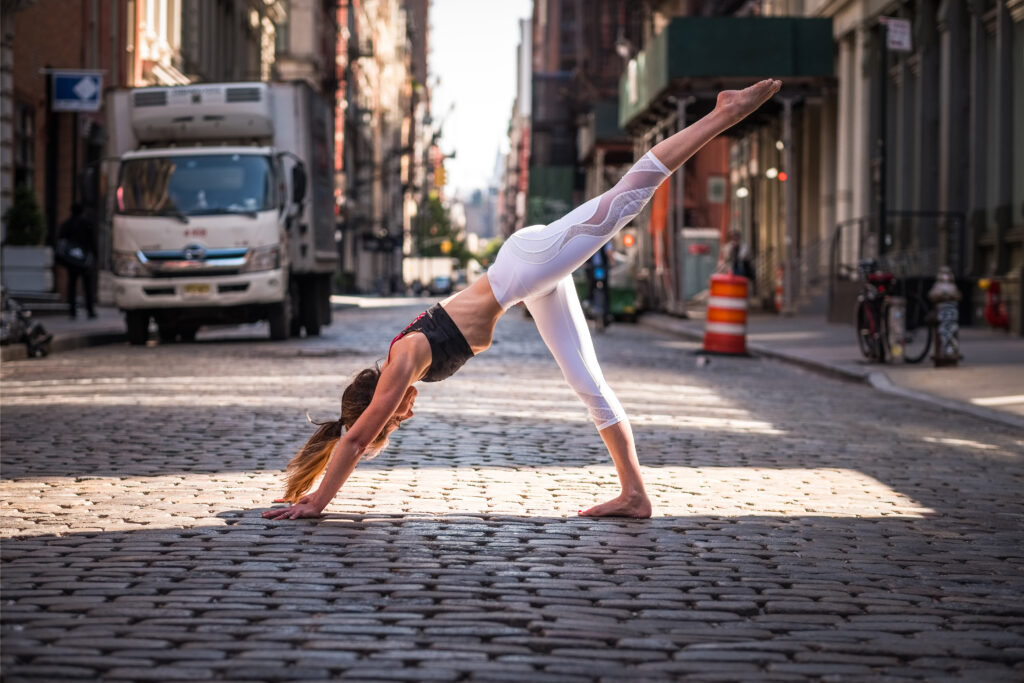Yogi’s have a special relationship with their shoulders. How many times do you actively remind yourself “I’m fine” after the 12th chaturanga or holding your arms in warrior 2 for what feels like an eternity.
We definitely know what it means to feel the burn when it comes to training our shoulders! And if you’ve ever had shoulder pain, you know how difficult a yoga practice can be on your shoulders sometimes.
In this article, I will teach you the three things you need for shoulder health, how to analyze your own shoulder function, and what to train to help those boulder shoulders keep functioning well into the 13th chaturanga.
But first, a little anatomy lesson. What are the shoulders?
Shoulder anatomy
It’s more than just the arm bone. The shoulder girdle consists of three bones articulating together – the humerus, the clavicle, and (one of my favorite bones) the scapula. There are 17 muscles that attach to the scapula alone. It’s an important bone! (rhyme intended hehe.)
The scapulohumeral and scapulothoracic regions are highly undertrained in most individuals and tend to significantly impact shoulder health if functioning sub-optimally. For example, if there is delayed scapular movement while lifting the arm overhead, it tends to cause impingement in the rotator cuff interval and lead to rotator cuff and/or bicep tendon breakdown from excessive shearing.
How do we keep the shoulder girdle functioning at 10/10 capacity? What do you need for healthy sustainable shoulders? Just like any other structure in the musculoskeletal and neuromuscular system, the shoulder girdle requires three simple things: mobility, stability, and adaptability to function optimally. Let’s look at these three categories and see how you can quickly analyze your shoulder function.
Analyze your shoulder function
Shoulder range of motion
Check your shoulder mobility by going through the ranges of motion below and ask yourself the following questions:
- Is shoulder motion equal side-to-side?
- Can you perform the motion without pain?
- Does it look to be full range of motion?
If you notice a range of motion deficit or pain, consider this an area to work on in your training plan.
Shoulder stability/strength
There are many ways to check for shoulder stability and strength including manual muscle tests and functional strength tests. Simple ways to test your own strength at home include the following exercises:
- Push-Up
- Plank for time (goal to hold for at least 60 seconds)
- Side plank for time (goal to hold for at least 30 seconds)
- Prone Superman lift
- Prone I, T, Y raise
- Lateral shoulder raise with weight
- Overhead shoulder press with weight
Ask yourself these questions when performing each movement:
- Can you perform the movement without pain?
- Does strength feel equal side to side and can you perform in the full range of motion?
If you notice a strength deficit or pain, consider this an area to work on in your training plan.
Shoulder adaptability
Finally, You want to assess shoulder adaptability by asking yourself the following questions:
- Can you perform your normal day-to-day tasks without shoulder pain during or after the activity?
- Do you experience shoulder pain during or after your yoga practice?
- Does your shoulder feel unsteady and/or weak with certain movement patterns?
- Do you avoid using your shoulder for specific tasks?
If the answers indicate pain and/or shoulder dysfunction, it’s showing you the shoulder is not adapting well to your normal lifestyle. If you’ve reached this point, I highly recommend seeing a professional such as your local physical therapist for a more in-depth analysis of your overall function and to assist you in your shoulder health journey.
Once you’ve done your assessment, now it’s time to go to work!
Train your shoulders
Use your home assessment to discover any weak points and make that your primary area of focus. When creating a home exercise plan, consider covering your basis with an exercise in each of the following categories:
| Category | Examples |
| Push | Yogi push-ups, down dog push-ups, down dog on the wall |
| Pull | Scapula squeezes in goddess, cobra, rows |
| Rotator Cuff Strengthening | Vasisthasana variations, down dog on the wall, banded 90-90 external rotation and internal rotation |
| Shoulder raises | Front and side raises |
| Other Scapular Stabilizers | Prone I, T, Y, W |
| Mobility | Child’s pose, open books, cat-cow, cow-facing arms (modified) |
Remember that shoulder pain could be coming from places other than the shoulder! Common areas that refer to the shoulder include the neck and the thoracic spine. It’s always a good idea to train the body holistically. LYT Yoga is amazing to do just that. If you are experiencing an active shoulder issue, don’t wait it out or feel like you have to figure it out on your own. The musculoskeletal and neuromuscular systems are intricately complicated. There are many people out there just like me who can’t wait to help you! But in the meantime, while you’re out there searching for the provider that is right for you, I hope this article helps.
Check out the shoulder section (https://lytyoga.uscreen.io/categories/category-shoulders) of the LYTDaily platform for yoga classes that target shoulder health.
I’ll see you on the mat!
Thalia Wynne, PT, DPT, AT, RYT
IG: @thalialovee (https://www.instagram.com/thalialovee/)
Picture sources:
1: Picture 1 https://aosmlv.com/. Available at: https://cdn-alkjn.nitrocdn.com/frcYdTXDhmUfxRRByQWQPKPCHPldUaLn/assets/images/optimized/rev-f0e72a2/wp-content/uploads/2022/08/aosmlv_shoulder.png. Accessed March 14, 2023.
2: Picture 2 McKay, D. (2022) Myotherapy, Remedial Massage & Sports Massage in Essendon: Upside Health & Movement: Available at https://www.upsidehealth.com.au/blog/pain-profile-snapping-scapula (Accessed: March 14, 2023).
3: Picture 3 Posturepro. Available at: https://education.posturepro.co/?fbclid=IwAR3lKVWNG9ipuelOgWutUcJlQBE7UIrJucTNTn5xHsebCqf1CK6UUVBYuIU (Accessed: March 14, 2023).
4: Picture 4 Cook, G. “FUNCTIONAL MOVEMENT SCREENING: THE USE OF FUNDAMENTAL MOVEMENTS AS AN ASSESSMENT OF FUNCTION,” IJSPT [Preprint]. Accessed March 14, 2023.






